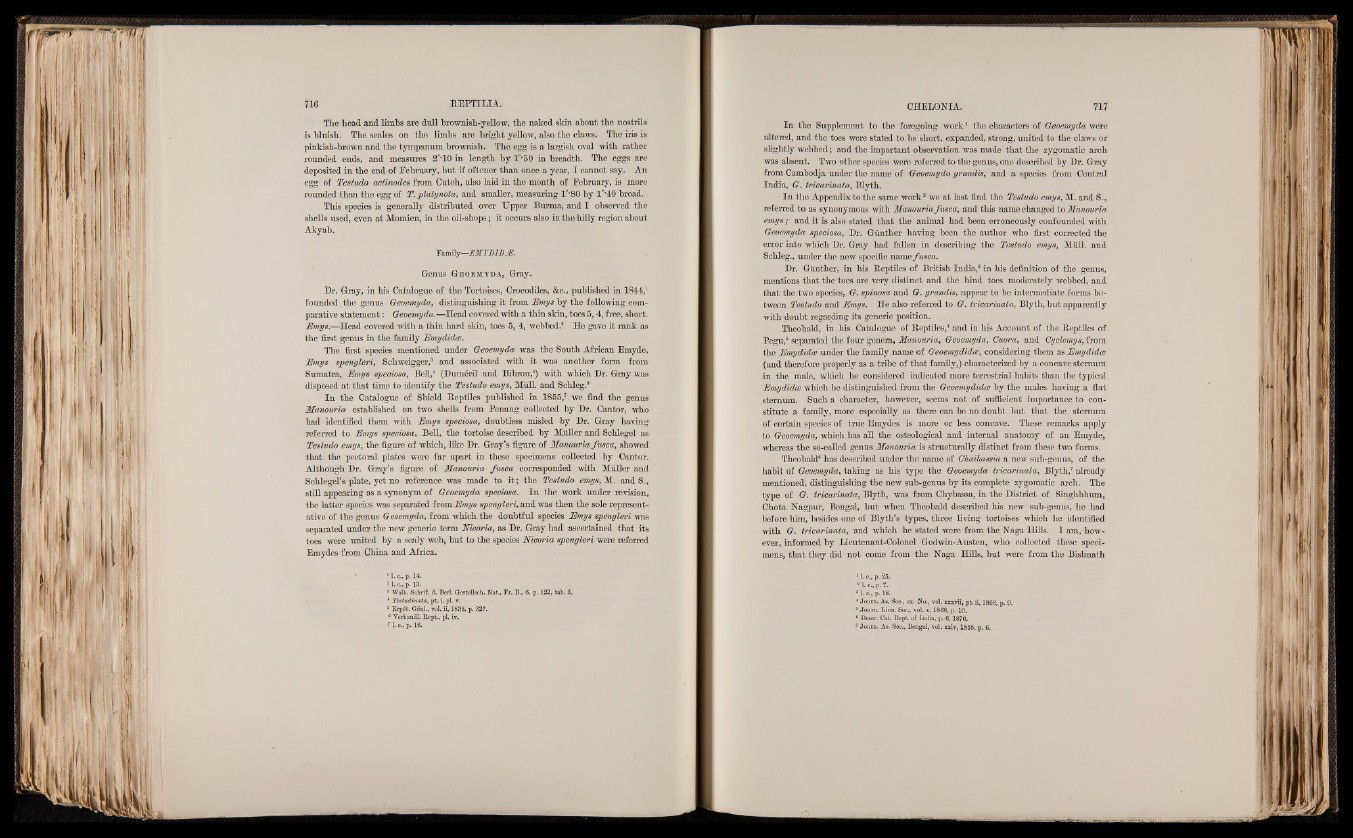
The head and limbs are dull brownish-yellow, the naked skin about the nostrils
is bluish. The scales on the limbs are bright yellow, also the claws. The iris is
pinkish-brown and the tympanum brownish. The egg is a largish oval with rather
rounded ends, and measures 2"'10 in length by 1"*50 in breadth. The eggs are
deposited in the end of February, but if oftener than once a year, I cannot say. An
egg of Testudo actinodes from Outch, also laid in the month of February, is more
rounded than the egg of T. platynota, and smaller, measuring 1"‘80 by 1"*40 broad.
This species is generally distributed over Upper Burma, and I observed the
shells used, even at Momien, in the oil-shops; it occurs also in the hilly region about
Akyab.
Family—EM YD ID JE.
Genus G e o e m y d a , Gray.
Ur. Gray, in his Catalogue of the Tortoises, Crocodiles, &c., published in 1844,1
founded the genus Geoemyda, distinguishing it from JEmys by the following comparative
statement: Geoemyda.—Head covered with a thin skin, toes 5,4, free, short.
Emys.—Head covered with a thin hard skin, toes 5, 4, webbed.8 He gave it rank as
the first genus in the family JEmydidce.
The first species mentioned under Geoemyda was the South African Emyde,
JEmys spengleri, Schweigger,3 and associated with it was another form from
Sumatra, JEmys speciosa, Bell,4 (Duméril and Bibron,6) with which Ur. Gray was
disposed at that timé to identify the Testudo emys, Müll, and Schleg.8
In the Catalogue of Shield Reptiles published in 1855,7 we find the genus
JMJanouria established on two shells from Penang collected by Ur. Cantor, who
had identified them with JEmys speciosa, doubtless misled by Ur. Gray having
referred to Emys speciosa, Bell, the tortoise described by Müller and Schlegel as
Testudo emys, the figure of which, like Ur. Gray’s figure of JMJanouria fusca, showed
that the pectoral plates were far apart in these specimens collected by Cantor..
Although Ur. Gray’s figure of Manou/ria fusca corresponded with Müller and
Schlegel’s plate, yet no reference was made to it; the Testudo emys, M. and S.,
still appearing as a synonym of Geoemyda speciosa. In the work under revision,
the latter species was separated from Emys spengleri, and was then the sole representative
of the genus Geoemyda, from which the doubtful species Emys spengleri was
separated under the new generic term Nicoria, as Ur. Gray had ascertained that its
toes were united by a scaly web, but to the species Nicoria spengleri were referred
Emydes from China and Africa.
•' *1.0., p. 14.
a 1. c., p. 13.
3 Walb. Schrif. d. Berl. Gestellsch. Nat., Fr. B., 6, p. 122, tab. 3,
* Testudinata, pt. i, pi. v.
6 Erpét. Génl., vol. ii, 1835, p. 327.
6 Verbandl. Kept., pi. iv.
7L-c,, p. 16. -
In the Supplement to the foregoing work1 the characters of Geoemyda were
altered, and the toes were stated to be short, expanded, strong, united to the claws or
slightly webbed; and the important observation was made that the zygomatic arch
was absent. Two other species were referred to the genus, one described by Ur. Gray
from Cambodja under the name of Geoemyda grandis, and a species from Central
India, G. tricarinata, Blyth.
In the Appendix to the same work8 we at last find the Testudo emys, M. and S.,
referred to as synonymous with Ma/nouria fusca, and this name changed to Manouria
emys; and it is also stated that the animal had been erroneously confounded with
Geoemyda speciosa, Ur. Günther having been the author who first corrected the
error into which Ur. Gray had fallen in describing the Testudo emys, Müll, and
Schleg., under the new specific namefusca.
Ur. Günther, in his Reptiles of British India,3 in his definition of the genus,
mentions that the toes are very distinct and the hind toes moderately webbed, and
that the two species, G. spinosa and G. grandis, appear to be intermediate forms between
Testudo and JEmys. He also referred to G. tricarmata,T!>\yt\i, but apparently
with doubt regarding its generic position.
Theobald, in his Catalogue of Reptiles,4 and in his Account of the Reptiles of
Pegu,6 separated the four genera, Ma/nouria, Geoemyda, Cuora, and Gyclemys, from
the JEmydidce under the family name of Geoemydidce, considering them as Emydidce
(and therefore properly as a tribe of that family,) characterized by a concave sternum
in the male, which he considered indicated more terrestrial habits than the typical.
JEmydidce which he distinguished from the Geoemydidce by the males having a flat
sternum. Such a character, however, seems not of sufficient importance to constitute
a family, more especially as there can be no doubt but that the sternum
of certain species of true Emydes is more or less concave. These remarks apply
to Geoemyda, which has all the osteological and internal anatomy of an Emyde,
whereas the so-called genus Mcmou/ria is structurally distinct from these two forms.
Theobald6 has described under the name of Chaibassia a new sub-genus, of the
habit of Geoemyda, taking as his type the Geoemyda tricarinata, Blyth,7 already
mentioned, distinguishing the new sub-genus by its complete zygomatic arch. The
type of G. tricarinata, Blyth, was from Chybassa, in the Uistrict of Singhbhum,
Ohota Nagpur, Bengal, but when Theobald described his new sub-genus, he had
before him, besides one of Blyth’s types, three living tortoises which he identified
with G. tricarinata, and which he stated were from the Naga Hills. I am, however,
informed by Lieutenant-Colonel Godwin-Austen, who collected these specimens,
that they did not come from the Naga Hills, but were from the Bishnath
11. o., p. 25.
* l.c ., p. 7.
31. o., p. 18.
* Joum. As. Soc., ex. No., vol. xxxvii, pt. ii, 1868, p. 9.
5 Journ. Linn. Soc., vol. x, 1868, p. 10.
6 ©esdr. Cat. Kept. of India, p. 6,1876.
7 Joum. As. Soc., Bengal, vol. xxiv, 1855, p. 6.